Midsummer is approaching here in the southern hemisphere. The summer solstice, which occurs in December, the first month of summer in Australia has been and gone, along with Christmas and New Year. Preparations are being made across the country for ‘Australia Day,’ celebrated on January 26, with a public holiday, national awards, and citizenship ceremonies. The date commemorates the day that colonisers from the First Fleet, led by Arthur Phillip, first raised the British Flag at Sydney Cove.
Although claims are made that ‘Australia Day’ celebrations bring the nation together, in reality, celebrating on this date causes great hurt and distress to our First Peoples and their supporters, and has historically divided the country since its inception. January 26 marks the start of invasion, the Frontier Wars, genocide, massacres, murders, rape, slavery, dispossession, stolen children, stolen land, stolen wages, cultural and environmental devastation, and other atrocities committed by British colonisers against Australia’s First Peoples. It also marks the physical and political resistance of our First Peoples and is considered a day of mourning rather than celebration. It is an awful date to be celebrating our nationhood and I will post in detail about it next week.
It would be so much better and more appropriate to celebrate ‘Australia Day’ on a different date so that we can honour, or at the very least include our First Peoples. It would also allow everyone to celebrate our beautiful country without the political and emotional charge of the current, despicable date. A better date would be no date at all and merely a seasonal marker for our Midsummer, say, the 4th Friday in January, giving us the public holiday and a long weekend to enjoy the day in a familiar and much-loved way (and also re-aligning it with Triple J’s Hottest 100 for modern music buffs). It has the added benefit of celebrating our Australian way of life with midsummer traditions from our Anglo-Saxon and multi-cultural heritage while honouring and showing pride in the heritage of our First Peoples. In some years, ‘Australia Day’ would fall on January 26, and it might be appropriate to publicly acknowledge ‘Invasion Day’ and its consequences for our First First Peoples.
Until then, let’s explore European Midsummer traditions to understand how they are reflected in Australia’s own, less formal summer celebrations.
European Midsummer Traditions
Fire and Flame
Many parts of Europe celebrate Midsummer at the summer solstice, on or near June 21 and these celebrations are often centred around bonfires, lit on the banks or nearby bodies of water.1
When midsomer comes, with bavens and bromes they do bonfires make, and swiftly, then, nimble young men runne leapinge over the same. The women and maydens together do couple their handes. With bagpipes sounde, they daunce a rounde; no malice among them standes.
These pre-Christian traditions sometimes involved rolling a burning cartwheel down a hill to a river. This was first documented in the 4th Century as part of the pagan Midsummer’s Eve celebrations in Aquitane, southwestern France. These customs survived in many places despite of, or through merging with Christian beliefs and the celebration day for St. John the Baptist.
A 13th-century monk from Winchcombe, Gloucestershire, England, recorded how St John's Eve was celebrated in his time:2
Let us speak of the revels which are accustomed to be made on St. John's Eve, of which there are three kinds. On St. John's Eve in certain regions the boys collect bones and certain other rubbish, and burn them, and therefrom a smoke is produced on the air. They also make brands and go about the fields with the brands. Thirdly, the wheel which they roll. ... The wheel is rolled to signify that the sun then rises to the highest point of its circle and at once turns back.
According to Christian beliefs, dragons, witches and evil spirits were abroad on St John’s Eve, and were thought to poison wells and springs. Saint John's Fires, explained the monk of Winchcombe, were an emblem of St John the Baptist and were lit to drive away dragons and repel witches and evil spirits.
The custom of the flaming cartwheel was described in detail by Protestants in the 16th century, who claimed it was a common Midsummer custom throughout northern Europe. In 1909, a British folklorist published a description of this custom from the Vale of Glamorgan, Wales, in the 1820s:
People conveyed trusses of straw to the top of the hill, where men and youths waited for the contributions. Women and girls were stationed at the bottom of the hill. Then a large cart wheel was thickly swathed with straw and not an inch of wood was left in sight. A pole was inserted through the centre of the wheel, so that the long ends extended about a yard on each side. If any straw remained, it was made up into torches at the top of tall sticks. At a given signal the wheel was lighted and set rolling downhill. If this fire-wheel went out before it reached the bottom of the hill, a very poor harvest was promised. If it kept lighted all the way down, and continued blazing for a long time, the harvest would be exceptionally abundant. Loud cheers and shouts accompanied the progress of the wheel.3
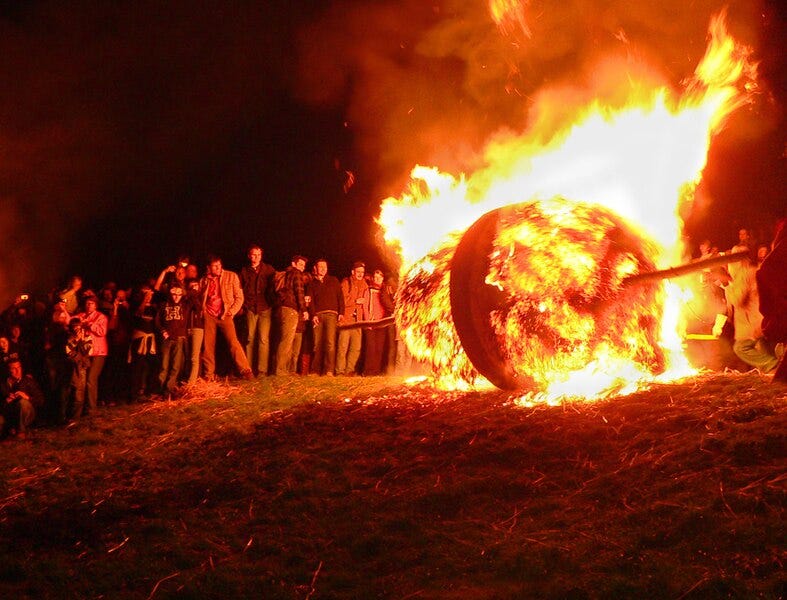
The burning wheel custom also forms part of the Slavic Midsummer celebration of Kupala (Midsummer Night) also called Ivan Kupala, with Ivan being the Russian-Ukranian name for John, as well as the Slovakian Midsummer celebration called Vajana. A similar custom for Midsummer can be found in Lithuania.
It is a festival of simple people, connected with the veneration of fire. Young girls adorn their heads with flower wreaths. A tall pole with a wooden wheel soaked in tar or filled with birch bark is hoisted at the top of the highest hill in the vicinity. Men whose names are Jonas (John) set the wheels on fire and make bonfires around it. In some places a second pole is hoisted with flowers and herbs. Young people dance round the fire, sing songs about rye, play games, men try to jump over the fire. The burning wheels on the poles are rolled down the hill into a river or a lake at its foot, men jumping over it all along.4
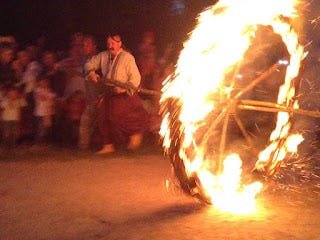
Bonfires also form part of Scandinavian Midsummer celebrations, which also mirror Spring May Day customs from the rest of Europe. The video below provides an excellent, and amusing summary about Midsummer in Sweden.
Water
Communal bathing in water like rivers, lakes or sacred springs, or steaming in banyas/saunas, for those who did not have easy access to bodies of water, was an important custom for those celebrating Kupala. It was believed that all evil spirits, like the rusalky or the vodyanoy, left the rivers and lakes on Kupala Day, making it safe to swim until Elijah’s Day at the start of Autumn. ‘Living’ water from flowing rivers, clear lakes and springs was believed to be endowed with revitalising properties and magical powers on Kupala Night. Wreaths were thrown in the water and if they floated it meant good luck and a long life or marriage.
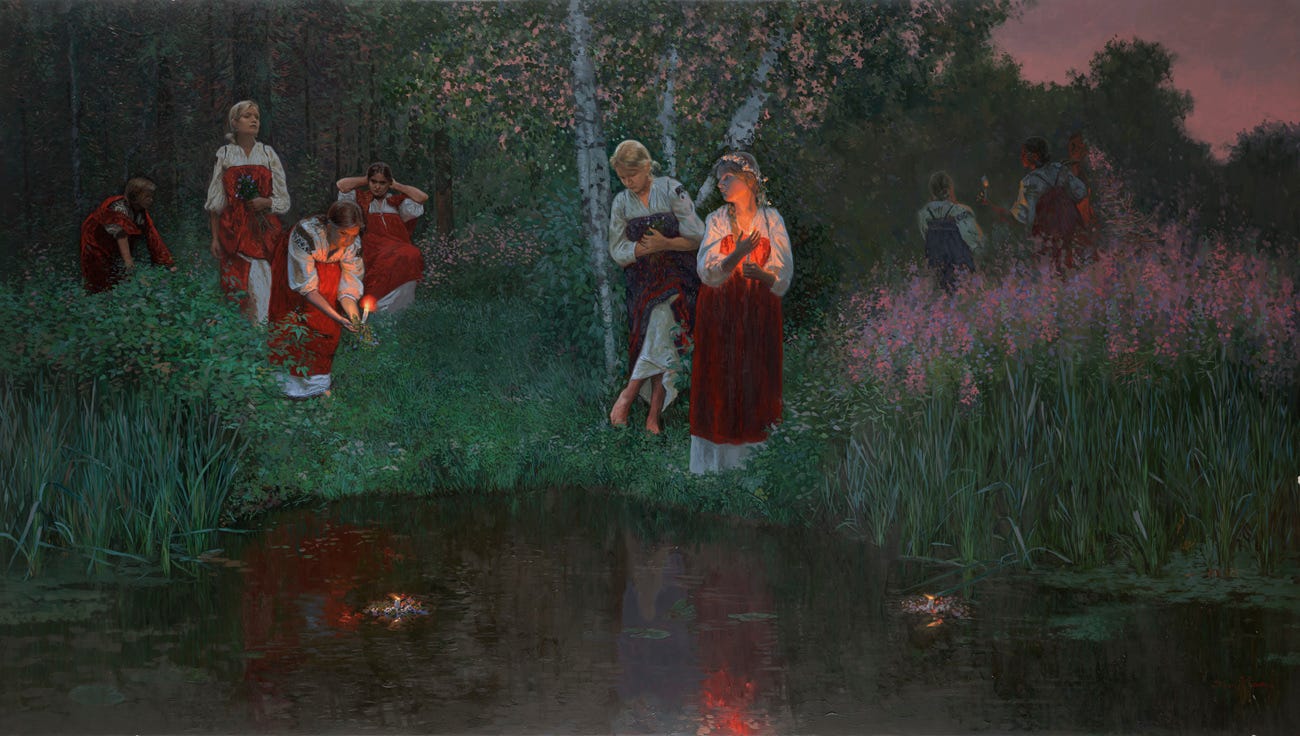
Flowers and Garlands
Midsummer celebrations often involve picnics and festivities away from cities and in the natural landscape, usually near bodies of water. The erection (excuse the pun) of a midsommarstång (maypole) garlanded with flowers, is integral to Midsummer celebrations in many parts of Scandinavia and is a remnant of pagan fertility rites. Women and children across many European cultures, collect wildflowers from fields and forests, making garlands to wear or using flowers for love divination. A common method of love divination was to gather seven types of wildflowers and place them under a pillow before sleeping on Midsummer’s Eve when dreams would reveal your future spouse. Midsummer was also a time to collect herbs for medicines when they were at their most potent.
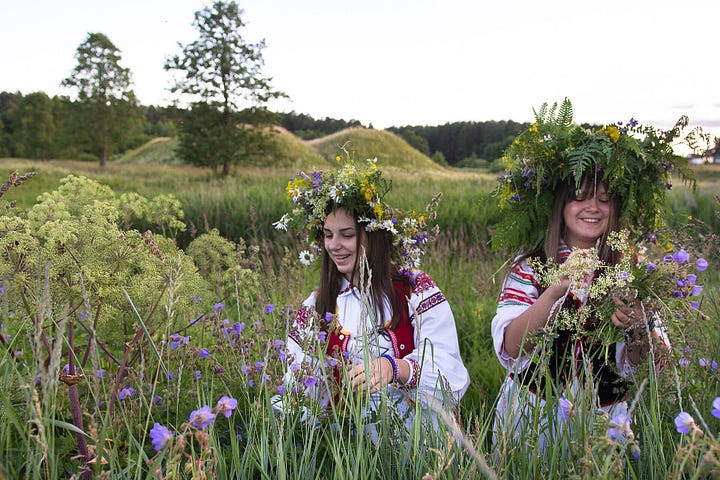
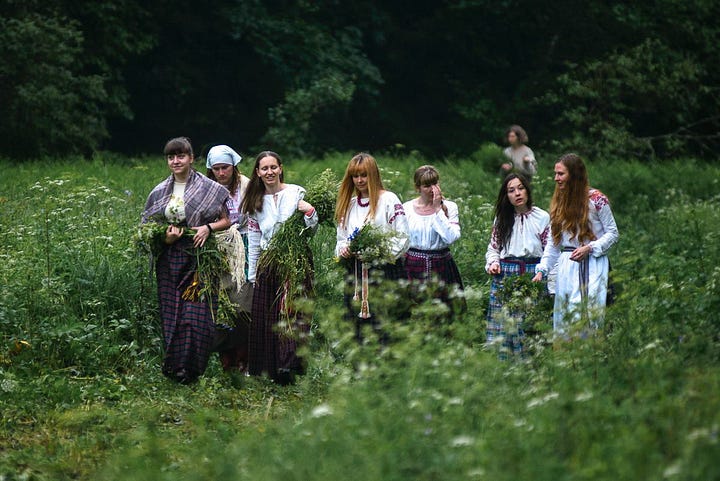
In Lithuania,
Medicinal herbs collected from June 1 to the Mid- summer Day can cure 12 (some say 99) diseases. There are girls who save their Midsummer Day's wreaths all the year round. Great importance is attached to the Midsummer Day's fire. Its embers are brought home to make the hearth fire, and its ashes are spread in the fields... Young people play games all through Midsummer Night until sunrise or until dew falls out, Girls float wreaths on rivers to find out their prospects for marriage. The farther their wreaths float the sooner they will get married. It is also very important which bank the wreath will stop at. Sometimes a burning candle or a bowl filled with burning tar is fixed in the middle of the wreath. A great number of Midsummer Night's superstitions and customs are similar to those observed on Christmas Eve. A girl will marry the man whom she will see in her dream walking along the straw placed across the bowl of water under her bed or who will dry his face on the towel placed beside her bed. The future husband will come from the direction in which she notices the first bonfire on Midsummer Night.5
Garlands developed into magnificent floral crowns called vinok worn by Ukranian women and children at Midsummer. The photos below of Ukranian women wearing vinok headdresses were taken by a group of Slavic photographers called Treti Pivni (Third Roosters). You can find more of their beautiful work on Instagram at third_roosters or on Facebook.

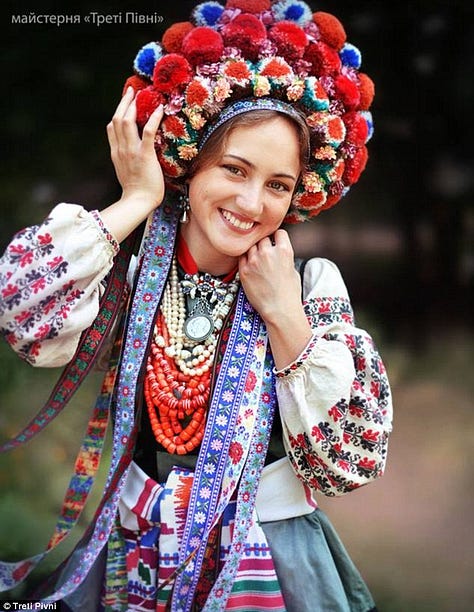
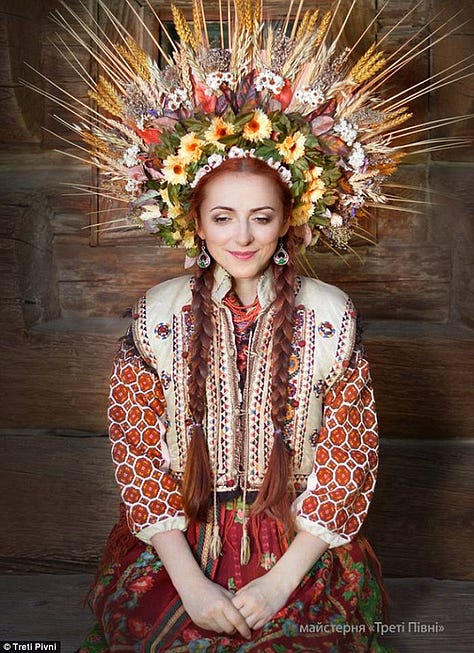
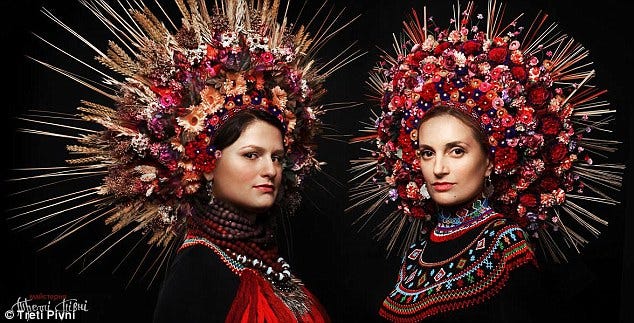
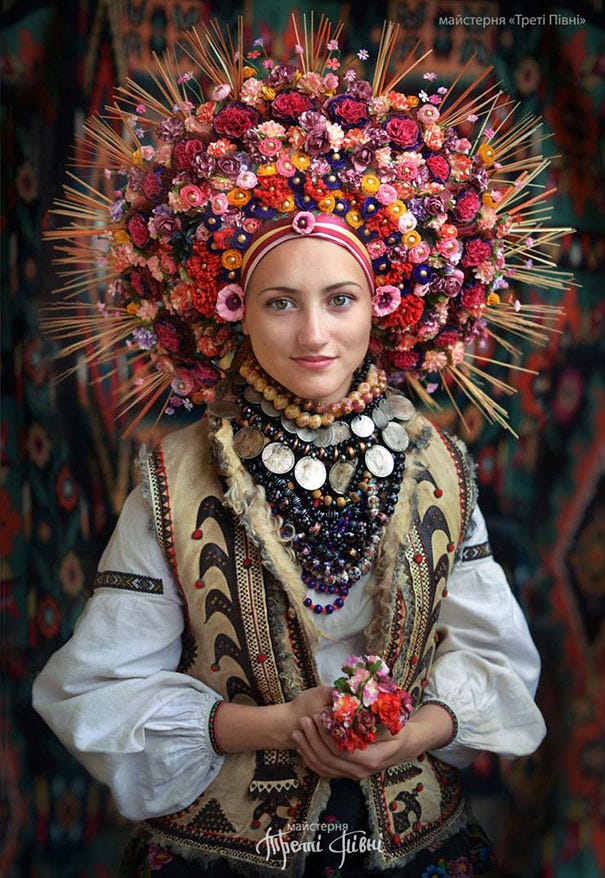
The Eurovision-worthy video (4:14 mins) below features Polish-Ukranian folk band Dagadana and their song celebrating Kupala, Schedryi vechir.
This second video (5:20 mins) features images of Kupala celebrations from around the Slavic world set to modern Slavic folk music.
Wikipedia provides a good summary of Midsummer traditions across Europe if you are interested in finding out more.
Aussie Summer Traditions
The Aussie BBQ
Lighting bonfires during Australia’s hot and dry summers is a pretty silly thing to do and it is illegal in areas where fire bans are in place. Luckily, even on total fire ban days we can still have our most sacred of Aussie customs, a BBQ (barbeque), preferably near the beach or other body of water, including the backyard pool. The video below features an amusing (and sometimes disturbingly accurate) song by The Wayfarers about the Aussie BBQ.
Triple J Hottest 100
Triple J is Australia’s government-funded, national radio station aimed at young listeners of alternative music. It began broadcasting in 1975 and is a division of the Australian Broadcasting Corporation (ABC). From mid-1992 to 2017, the Triple J Hottest 100 most popular songs in Australia were counted down on Australia Day and were an integral part of celebrations for many Australians. However, the Hottest 100 countdown was moved to the fourth Saturday in January to avoid the heated political debate about the date of ‘Australia Day’.
Midsummer Night’s Dream
We can’t talk about Midsummer without mentioning William Shakespeare’s famous play, A Midsummer Night's Dream. Set in a magical forest during the summer solstice, it portrays mischievous fairies meddling in the lives of mortals, steeped in the folklore surrounding midsummer night. The short (4:43 mins) video below provides an excellent summary.
The play has been performed many times over the centuries, from its first performance in 1595 and has been adapted for film several times. The video (1:26 mins) below features a trailer for the 1999 film.
I hope you enjoyed learning about European and Australian Midsummer customs and traditions. Next week we’ll explore the issues with celebrating ‘Australia Day’ on a day of mourning for our First Peoples.
In the meantime, I give you words from William Shakespeare’s A Midsummer Night’s Dream:
I know a bank where the wild thyme blows,
Where oxlips and the nodding violet grows,
Quite over-canopied with luscious woodbine,
With sweet musk-roses and with eglantine.
Oberon (act 2, scene 1)
Oh what fools these mortals be
Robin (act 3, scene 2)
The Merry Life of the Countriman (1585-1603), in ‘The Stations of the Sun: A history of the Ritual Year in Britain,’ Ronald Hutton (2001).
British Library Harleian Mss 2345, edited by J. Kemble, The Saxons in England, vol. I:361, quoted in George C. Homans, English Villagers of the Thirteenth Century, 2nd ed. 1991. pp.369-370.
British Library Harleian Mss 2345, edited by J. Kemble, The Saxons in England, vol. I:361, quoted in George C. Homans, English Villagers of the Thirteenth Century, 2nd ed. 1991. pp.369-370.
Juozas Kudirka (1991) The Lithuanians: an ethnic portrait
Juozas Kudirka (1991) The Lithuanians: an ethnic portrait







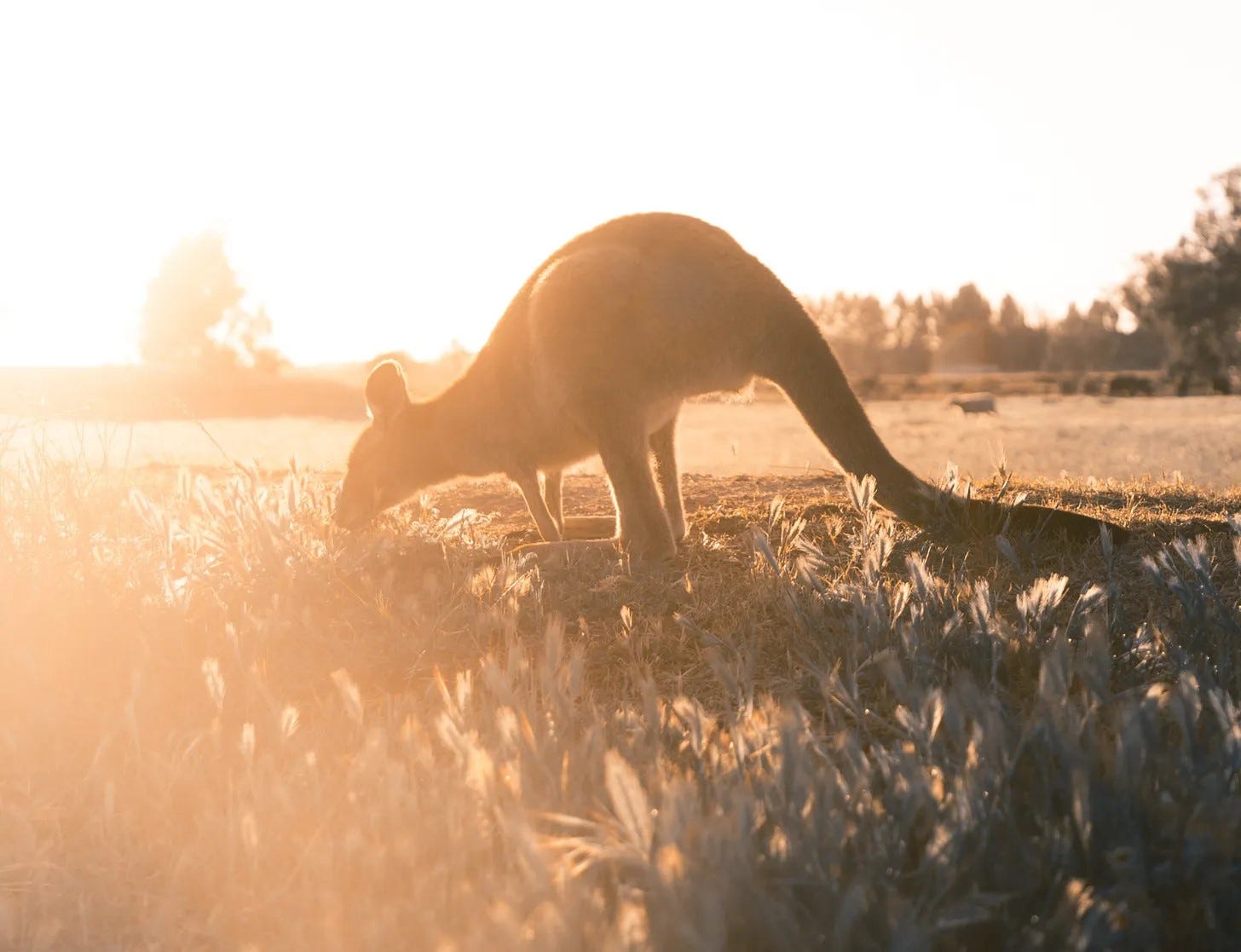




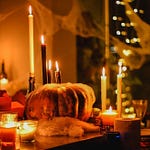




Share this post